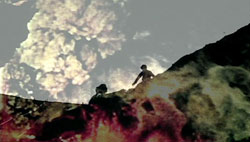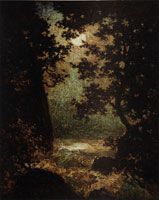F.I.L.M. at Hamilton College
Forum on Image and Language in Motion
Sunday Series
9/19 Saturday DOUBLE FEATURE:
So Yong Kim with In Between Days (2006) at 7pm;
Brad Rust Gray's The Exploding Girl (2009) at 9pm
9/20: So Yong Kim's Treeless Mountain (2008) at 2pm

So Yong Kim and Brad Rust Gray are two of the most impressive and original young independent filmmakers working, and working together, in the United States. Kim, a Korean native and graduate of the Chicago Art Institute school finished a series of experimental short films before completing the two remarkable, largely autobiographical features scheduled for her visit. Gray has degrees from the Art Institute, University of Southern California and the British Film Institute; The Exploding Girl is his second feature.
In Between Days focuses on an adolescent girl recently arrived in the United States from Korea and struggling to find a place for herself in a land whose language and customs she barely understands (Special Jury Prize at Sundance). The Exploding Girl is a portrait of a college girl and boy on spring break, working to understand the fine line between friendship and desire (currently premiering at festivals).
Treeless Mountain is about two young Korean girls living through their parents' divorce. Wonderfully acted by five- and six-year-olds, this film was conceived as a letter from Kim to her mother.
So Yong Kim's and Brad Rust Gray's website
9/27: The Alloy Orchestra with Dziga Vertov's The Man with a Movie Camera (1929) at 2pm

"The best in the world at accompanying silent film" (Roger Ebert), the Alloy trio-Terry Donahue (accordion, musical saw, junk, vocals), Roger Miller (keyboards), and Ken Winokur (clarinet and junk percussion)-return to accompany one of the great silent films. Vertov's The Man with a Movie Camera is a landmark in the histories of documentary, avant-garde film, and film editing. It is a paean to the then-young communist Russia during that golden moment when artistic experiment was encouraged and supported by the Russian government. Alloy's soundtrack, probably their finest, communicates this classic film's remarkable energy.
10/4: Jennifer Todd Reeves presents When It Was Blue (2008) at 2pm

Jennifer Reeves is an internationally recognized experimental filmmaker, whose works include her breakthrough psychodrama, Chronic (1996), and a series of remarkable films produced by painting and etching directly on the 16mm filmstrip. Reeves returns to Hamilton to present her most recent work, When It Was Blue, a double-projector performance piece that premiered at the Toronto Film Festival last year. Lucien Castaing-Taylor, director of the Sensuous Ethnography Program at Harvard, called it one of the most beautiful nature films he's ever seen; and critic Michael Sisinski has described Reeves's experimental environmentalist piece as a challenge to the controlling (and historically male) gaze of cinema: "From the very opening shots of When It Was Blue, some intuitive, nonlinguistic, and non-ideological part of us, some place governed by impulse and affect, almost reflexively grasps Reeves' gesture, producing an almost palpable bodily shock."
10/11: Sharmeen Obaid-Chinoy presents Pakistan's Taliban Generation (2009) at 2pm
Watch for announcements of other Obaid-Chinoy screenings, to be scheduled in advance of her visit.
During the last seven years Sharmeen Obaid-Chinoy has directed and/or has appeared in films for CNN, PBS, Channel 4 (U.K.) and the Discovery channel. These films have earned an Overseas Press Club Award, an American Women and Radio and Television Award, a Cine Golden Eagle, and the South Asian Journalist Award; and Obaid-Chinoy is the first non-American journalist to be awarded the prestigious Livingston Award and the youngest recipient of the One World Media broadcast journalist of the year award in the United Kingdom. Born in Karachi, Pakistan, Obaid-Chinoy was the first woman in her family to receive a Western education. She graduated from Smith College with a BA in economics and government and then completed MA degrees at Stanford University in International Policy Studies and Communication.
With the recent attack in Lahore on the Sri Lankan cricket team, the massive suicide bombing in Islamabad, and an assault on Mumbai, Pakistan's radical Islamists are bringing violence to the major cities of Pakistan and beyond. In her newest film (a collaboration with Dan Edge) Obaid-Chinoy travels across Pakistan to investigate how the far the Taliban has infiltrated her country.
Sharmeen Obaid-Chinoy's website
10/25: Professor Dan Streible lectures on early fight films at 2pm
NYU professor Dan Streibel has been a major contributor to our understanding of film history. He was the creator and remains the director of the renowned Orphans Film Symposium, a biennial event dedicated to rescuing us from cultural amnesia by retrieving important cinematic documents from the cultural trash heap.
Streible is also an accomplished scholar: his Fight Pictures: A History of Boxing and Early Cinema was published by the University of California Press in 2008. "Men in skimpy clothing engaged in the manly art of beating on each other became the cinema's very first movie stars" (Tom Gunning)-Streible will explore this phenomenon, with the help of imagery from the era.
11/1: Cine-Nocturnes, a presentation by Professor Scott MacDonald at 2pm

One of the sources of inspiration for cinema was 19th Century American landscape painting and painted panoramas; and film history has continued to profit from this history. At the close of the 19th Century one of the forms of landscape painting most in vogue was the nocturne: moonlit evening scenes. James McNeill Whistler and Ralph Albert Blakelock were major contributors to this form (Beethoven, Debussy, and Erik Satie composed well-known musical nocturnes). Hamilton professor and F.I.L.M. director Scott MacDonald will present a selection of cinematic nocturnes by Americans Peter Hutton and Philip Solomon, British filmmaker Laura Waddington, and Iranian Abbas Kiarostami.
11/8: A Journey Reunion at 1pm
In 1984 hundreds of Central New York residents, including Hamilton College faculty and students, worked with Academy-Award-winning director Peter Watkins (The War Game was named Best Documentary in 1965) on what became The Journey, which premiered in 1987 as a major event at the Berlin Film Festival. The Journey is a 14 1/2 -hour film (mini-series, if you like) that explores the ways in which our educational and media systems process information about crucial issues; the film offers an alternative way of thinking about how media can function within a democracy. We will present an excerpt from The Journey, followed by a discussion with some of those who made major contributions to the Mohawk Valley sequences of the film, including pollster John Zogby; Robert Baber, dean of Pratt Art School at the Munson-Williams-Proctor Arts Institute; and Rick Werner, Professor of Religion at Hamilton. Hopefully, Watkins will join us via a Skype connection.
11/15: Arthur and Jennifer Smith present Ice Bears of the Beaufort (2008) at 2pm

Jennifer and Arthur Smith live on the northern coast of Alaska, where they have devoted years to recording the lives of polar bears. In 2008 their collaboration produced Ice Bears of the Beaufort, a remarkable nature film with a clear environmentalist politic that won the grand prize at this year's Black Maria Film Festival.
As a result of our developing environmental crisis, nature filmmaking has become an avenue for proactive resistance to the status quo, and those women and men who put their lives on the line to bring the realities of environmental change to us are heroes of this resistance and a new kind of cinematic avant-garde. After the screening, the Smiths will talk about Ice Bears and the nature of their collaboration.